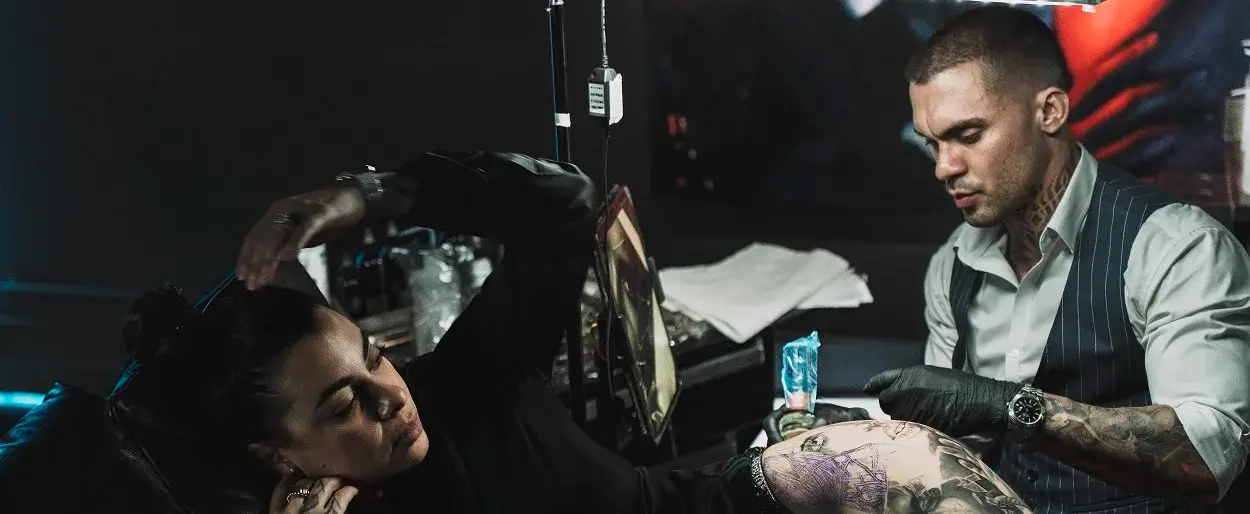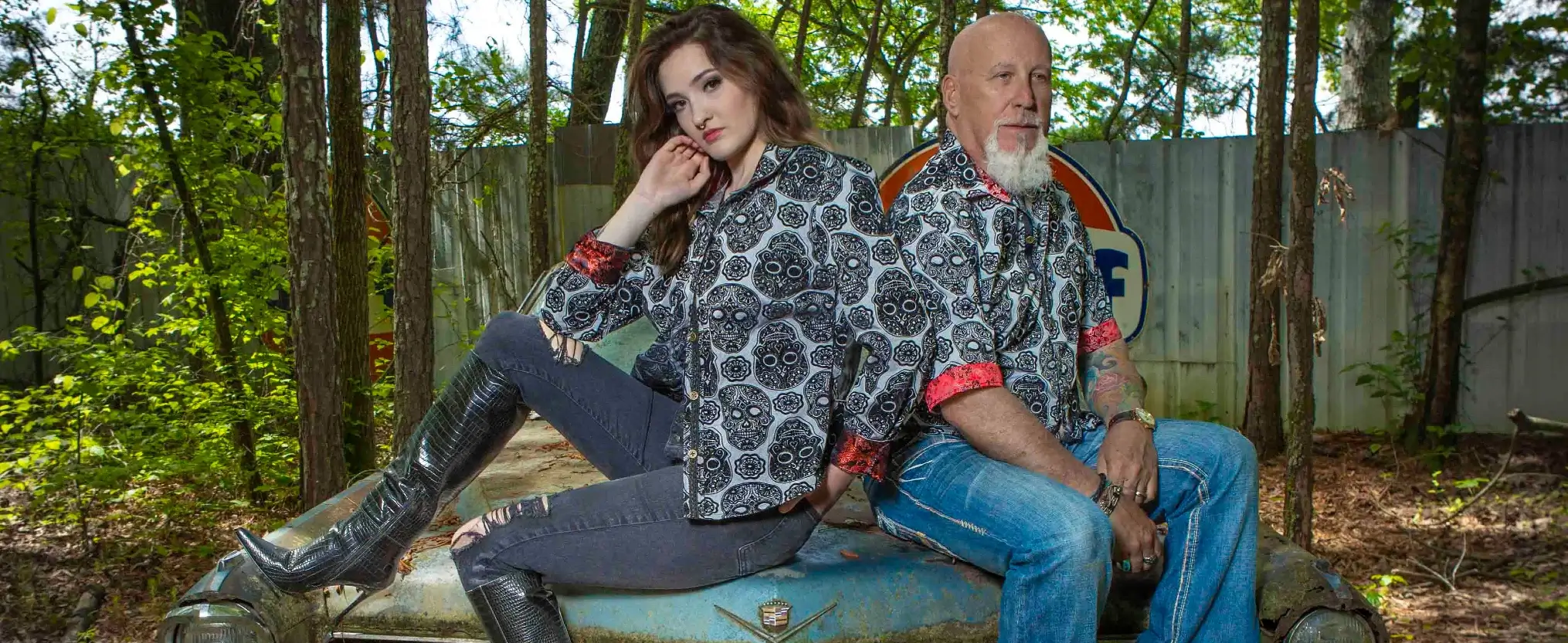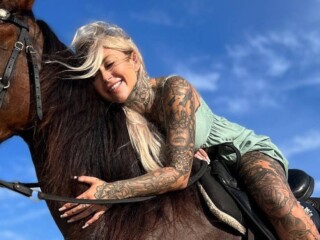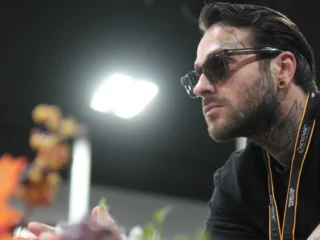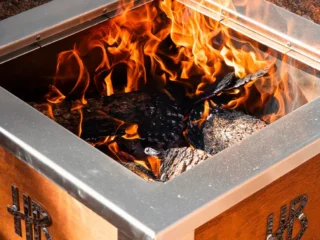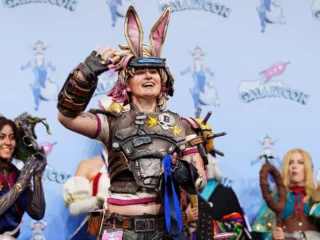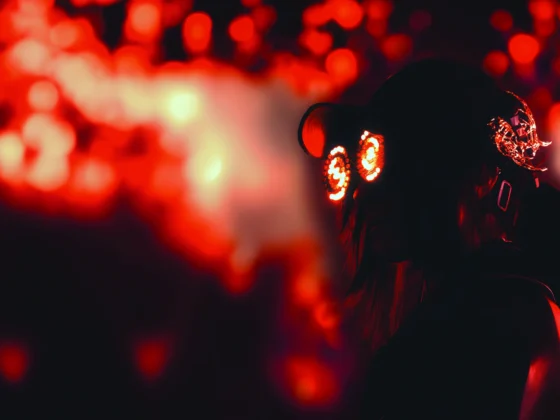Inked Mag Staff
June 10th, 2022
Storytelling Is Everything
Tattoo artist BJ Betts sits down with designer Frank Cooke to discuss the creative process, finding inspiration and the importance of storytelling
Ever since an underage Frank Cooke walked into BJ Betts’ shop hoping the tattooer would look the other way and hook him up, the two creative powerhouses have been close friends. Betts struck up a conversation with the renowned sneaker designer and let us listen in as they discussed where they find inspiration, the importance of positivity and how the key to any design is the story behind it.
BJ Betts: What was the sneaker and tattoo scene like where you grew up?
Frank Cooke: As far as sneakers and fashion go, it was a small town but it was kind of rich in content. Of course we had the staple sneaker stores—Sports Connection, even down to Foot Locker. And then having that flavor from Philly 29 miles away and being able to go to City Blue and Dr. Denim to shop. Sneaker culture was pretty prevalent there and everybody always gets fly no matter what. Having that influence really shaped what I wanted to do as a career in footwear and apparel.
As far as the tattoo scene, I was a kid, man. I always went to Borders bookstores and I would get a bunch of tattoo magazines. My mom and dad would be like, “What are you looking at?” I always thought tattoos were super unique and different. Plus having to go through pain to earn something on your body was a different kind of therapy for me. When I first met you at August Moon, that was after the sneakers and it was cool because the shop was less than a mile away from my house. So I could literally walk there. When I was old enough, I would just come home and my dad was like, “What is that? Did you get another one?” I just got hooked after that because I’ve always wanted to be super tattooed.
BB: Hell yeah. Which clearly you are, at this point.
FC: I’m getting there.
BB: I’m sure you’ve heard this question a lot, but what was your first sneaker memory?
FC: I guess the first pair that I really went, “Wow, this shoe is amazing,” were the Deion Sanders Diamond Turfs. I was in the second grade and one of my classmates walked in with them and I was like, “Yo, those are crazy.” My mom was a hairstylist so on Saturdays after her appointments she would go to the mall. I remember going to the mall to the Foot Locker and I was like, “Mom, I must have these.” This was before things would sell out and I had to sweep some hair and do a couple of knick-knack things before she wound up getting me a pair of those. And that was it from there. Everybody would say, “Whoa, those are cool,” not just kids, but adults. I just loved that feeling, down to the smell of the glue when you opened up the box. After that, I was pretty much hooked.

BB: We obviously know a lot of the same folks that share the same love of footwear—and tattoos, for that matter. I get asked a lot, and I’m sure you do as well, “Yo, man, you’ve got hundreds or thousands of pairs of shoes. You still get excited?” For me, hell yeah. I still get excited opening that box and smelling that distinct smell. Anyway, hit me with your top three favorite silhouettes.
FC: My No. 1 would definitely be the Jordan 11. I have a funny relationship with it because I always collect them and it’s my favorite shoe to look at aesthetically, but I don’t wear ’em. It doesn’t go well with my fits, but it’s still my favorite shoe.
Actually, it’s funny, when you were talking about Top 3… my No. 2 is one that probably nobody would think of, but one I got a chance to work on—the Fila Grant Hill 2. I know that’s a reach, but I always say it because at the time a lot of people were on the fence about either the Jordans or those. Those were smashing. Most of my collection and most of the things that I’m into are Nike and Jordan, but thinking outside the box, definitely that Grant Hill 2.
The three slot is very hard for me, but definitely the Jordan 1. I just think, it’s so close to the dunk, and working on those you can do so much with the different panels. For me, I remember a time when I was working at Foot Action in high school, it was so good for me because stuff would go on sale because people weren’t really feeling 1s then. It was different for me to wear 1s since people weren’t on them then. I’m glad it turned over and became the franchise sneaker that it is now, but I just remember those days when they were accessible. It was a different time.
BB: To double back on the other point, what’s your favorite pair that you’ve worked on?
FC: For me, the AJ 1 Top 3, because it was a brand story. It was an original story and I was able to mash up the 1s that we consider the grails. At first I started to do all four as a Top 1, but it just came out better as the 3—the Royal, the Chicago and the Bred.
BB: There are so many that you’ve done and worked on that have a story, which is one of the reasons why, in my opinion, you were very successful in that design world. You brought things to the table that, dare I say, were missing from the brand and from the design aspect of things. You had a different story and you brought a new perspective. How did you make the jump from retail to the biggest sneaker company in the whole world?
FC: When I was in retail, it was a time when collaborations weren’t really as heavy as they are now. So I’m so thankful for them giving me that creative buyer position and allowing me to work on different collaborations. Not only just as a chance to be creative, but to be able to build relationships with different brands. I’ve always been intrigued with there being a good story behind a shoe. You’d see some capsules or some stories, like the Shattered Backboard 2.0, and it was always drawing back to MJ’s career. I always wanted to expand past that because the truth of the matter is that not every kid would know his legacy. I just wanted to speak to the people with things these kids could relate to. Like taking a risk on No Photos. I knew that sneaker culture was like, “They take pictures of their shoes, they don’t want to crease their shoes,” and different things. I could have taken an L on that, poking at the footwear industry, but telling those different kinds of stories and having the kids involved brought me a lot of joy.

BB: What is it like to design art for mass consumption? Thinking about trying to make things that are accepted in some sort of capacity and not just entirely for yourself?
FC: I know you know this feeling with tattooing, what you do is forever. For somebody to trust you with that is such an awesome feeling and I commend you on that. It’s such a big commitment. That feeling is something different.
BB: When you’re designing something for mass consumption there is the potentiality of how critical people might be. When it comes to tattooing, and for what we both do as designers, you can’t make everybody happy. Thinking about the mass consumption, I’ve been fortunate enough to work with a number of brands, but there is that fine line that you have to think about and not make it just completely for yourself.
FC: For me, I go into it with confidence. I definitely always want to approach every project with confidence. In the back of my mind I know that you’re not always going to hit a home run, but I definitely want to get on base. I’m totally thankful that people are receptive to my way of thinking, to my storytelling. There have been some times when I’ve been nervous, and there are times when I’ve dropped a dud. I just want people to feel, right? You can like it, you can hate it or you can be in the middle and on the fence about it, but as long as you feel something from what I designed, that’s all that really matters to me.
BB: Obviously there is a huge brand legacy with Nike and Jordan, does that legacy influence your design in any kind of way?
FC: Absolutely. I’m always thinking about the people who came before me and the people that will come after me. I was very fortunate to be able to work on a campus and work with some legends. I think about my childhood and that feeling of opening up that box to actually building shoes, it was a dream come true and I’ve never taken that for granted. I was on campus a couple of days ago, showing my friend around, and I still get the chills thinking about the John McEnroes, the Andre Agassis, the Jordans, the Kobes, the Pennys—that is a major, major part of my life. And to be able to bring that part of my life and work on that stuff was a total blessing.
BB: On the opposite end of how the legacy has influenced your design, what limitations have you run into in design?
FC: That’s a great question. Sometimes in building shoes I have learned there are certain restrictions as far as materials that you can’t work with. Or sometimes you have to meet a certain margin, so you just can’t afford the materials or the process as to how the shoe would have to be built. There have been some of those challenges that are like, dang. For the most part, that was the dream of the job, right? To take things far and beyond whatever I could imagine and tell these stories that I’ve had in my mind since I was a child.
BB: Your Instagram feed is filled with shoutouts to other designers and the work that they do. So let’s talk a little about the positivity of all that, building people up.
FC: I’m not just blowing smoke, I feel very inspired by people. I’m inspired by my peers when they have projects coming out. I love to see how they have their way of thinking and I have mine. It’s cool to see that. I know when you’re on social media a lot of kids are watching, and hopefully my story can inspire. I know these kids are up next and they’re going to do a way better job than I’ll ever do.

BB: I say that all the time. The next BJ Betts and the next Frank are in middle school right now, you know. And he or she is going to come out of nowhere and we’ll be like, “Damn, I never thought of that.”
I recently went with you to go see your uncle speak about his book (Larry Miller, “Jump: My Secret Journey from the Streets to the Boardroom”), and he talked a lot about the struggles he had as a person of color working within the industry. What do you think is the importance of having people like him, and other people of color, working within the sneaker industry?
FC: People of color definitely need to be involved because the majority of the spending dollars in that industry come from people of color. I feel like if people of color are able to cop, they should be able to work on it as well. The industry is starting to get a lot more diverse, especially with women. I’m very glad to see women having a voice within the footwear industry and killing it. Some of the top designs, whether you’re talking about Cynthia Lu of Cactus Plant or Alelai May or Yoon Ahn from Ambush, it’s like we’re starting to see this whole change. It’s super exciting and I’m here for it.
BB: You’re clearly very heavily covered, do you have a similar design process or thought process when it comes to your ink? As far as placement goes, do you look at that in any kind of the same way as you would designing a shoe?
FC: When I first started getting tattooed I wanted everything to be curated. I wanted to make sure the clouds and the cherubs were in certain positions on my sleeves, you know. But over the years, man, I’ve started to see my body as a storybook. It shows different aspects and times of my life, the things that influenced me, the things that are near and dear to me. It’s a mixture of some fun tattoos—as you know, one of my favorite tattoos/gas stations/stores/delis is Wawa. So if it’s down to that tattoo or something serious like my cousin dying, it’s the storybook of my life and my body’s the canvas. There are definitely some places I still want to get tattooed but you’ve got to build up that courage to take it [laughs].
BB: I don’t think every tattoo has a deep meaning. Because of the internet and tattoo shows on TV everybody thinks tattoos need to have some crazy, deep meaning. I have a tiger on my forearm because I wanted a tiger. I didn’t get it because my grandfather died in a tiger hunting accident [laughs]. This is no dig or no offense to anybody who does have crazy meaningful tattoos, but you’re right, man. That’s one of the reasons it works to think of it in the bigger picture where you like all these different things, you collect all this different art and it works together. I look at every single tattoo and I can remember who did it, where I was in my life, where I was in my headspace. That’s why I haven’t gotten a lot of tattoos covered up.
FC: I’ve got nothing covered up. Ever. It’s funny in that way, because I do the same exact thing with footwear. I can tell you where I was when I copped those Jordan 11s or when this came out. Since being born in ’85, every year a Jordan came out and my life goes with every Jordan like on queue. It’s cool to have that kind of catalog with shoes.

Editor's Picks
Bridging Classical Art and Modern Tattooing
Esteban Rodriguez brings the discipline of classical fine art to the living canvas of skin, creating hyper-realistic tattoos that merge technical mastery with emotional depth.
Show Your Ink Fashions Brings Custom Style to Tattoo Culture
Show Your Ink Fashions creates custom shirts designed to showcase your tattoos as wearable art, blending fashion with personal expression.
The Ultimate “Superman” Tattoo Roundup: Just in Time for Superman’s Return to Screens
With Superman’s big return to theaters, fans are revisiting some of the most iconic ink inspired by the Man of Steel.


